Have you ever wondered why your cat meows incessantly when you step into the bathroom? It’s a common behavior that many cat owners experience, and there are several reasons behind this feline vocalization. Let’s dive deeper into the world of cat meowing in the bathroom and understand what your furry friend is trying to communicate.
When it comes to meowing in the bathroom, there can be a variety of motivations behind your cat’s vocalizations. From excitement to requesting assistance, your cat’s meows can reveal important insights into their needs and emotions. It’s essential to decipher these meows to ensure a harmonious bathroom experience for both you and your cat.
Key Takeaways:
- Understanding why cats meow in the bathroom can help you meet their needs effectively.
- Cats may meow in the bathroom due to excitement, requesting assistance, or expressing discomfort.
- Some common reasons for meowing include a desire for rewards, asking for cleaning, or indicating pain.
- Environmental stressors and changes in routine can also contribute to excessive meowing in the bathroom.
- Consulting a veterinarian is important if the meowing becomes excessive or is accompanied by concerning signs.
Why Do Cats Meow After They Poop?
After a cat takes care of their business in the litter box, you may notice that they start meowing. This behavior can have various reasons and understanding them can help create a harmonious bathroom experience for both you and your feline friend.
Cats may meow after pooping out of excitement. Just like humans, cats can feel a sense of relief after a successful elimination. Meowing can be their way of expressing this excitement and celebrating their accomplishment.
Another reason for a cat’s post-poop meowing could be their way of asking for assistance. If a cat is unable to eliminate or is experiencing discomfort, they may use vocalization to communicate their need for help. This could indicate constipation, difficulty in eliminating, or intestinal blockages that require attention.
Additionally, cats may meow after pooping to request a reward. This behavior is common if they have been recently litter trained and expect positive reinforcement for using the litter box. Providing verbal encouragement or gentle petting can fulfill this expectation and reinforce their litter box habits.
| Reasons Why Cats Meow After Pooping |
|---|
| Excitement |
| Requesting Assistance |
| Requesting a Reward |
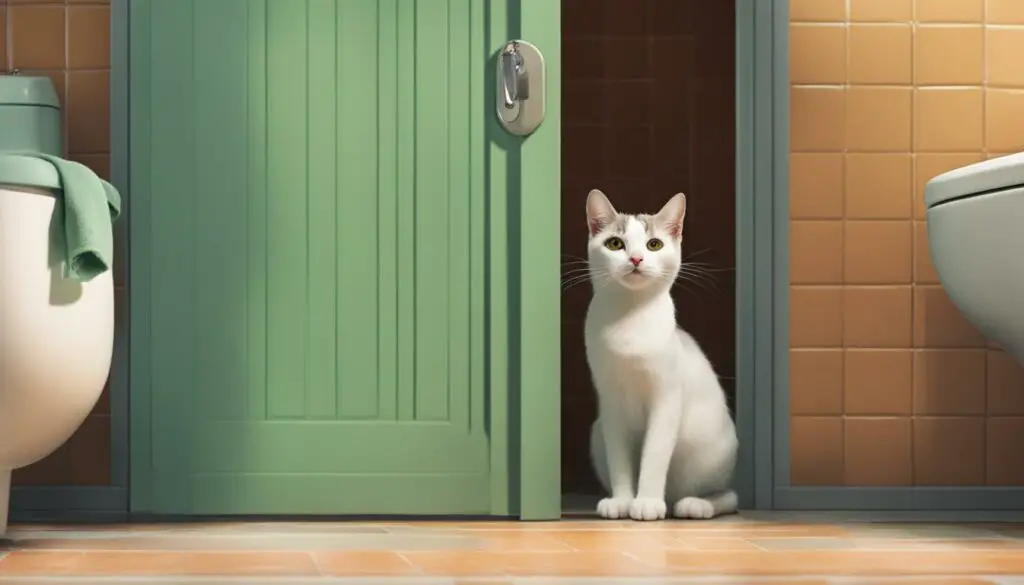
If you notice your cat meowing after using the litter box, it’s essential to pay attention to their behavior and determine the underlying cause. In some cases, it may simply be a vocal expression of excitement or happiness. However, if the meowing becomes excessive or is accompanied by signs of discomfort, it’s advisable to consult a veterinarian. They can assess your cat’s health and provide guidance on addressing any medical or behavioral issues.
By understanding the reasons behind a cat’s meowing after they poop, you can better respond to their needs and ensure a comfortable bathroom experience for your furry companion.
Excitement after Using the Litter Tray
After using the litter tray, cats may exhibit bursts of excitement. This behavior is often characterized by energetic movements and increased vocalization. It is their way of expressing contentment and satisfaction with a successful bowel movement.
During this period of excitement, cats may engage in playful behavior, such as racing around the house or pouncing on toys. This active display is a natural response to the release of pent-up energy after using the litter tray. It also serves as a form of scent marking, as cats rub against furniture and walls to share the scent of their waste, further solidifying their territory.
If you observe your cat meowing and darting around the bathroom or the rest of the house after using the litter tray, it’s a clear sign that they are feeling happy and fulfilled. This behavior is perfectly normal and should not be a cause for concern. Engaging in interactive play sessions with your cat can help channel their excitement in a positive and stimulating way.
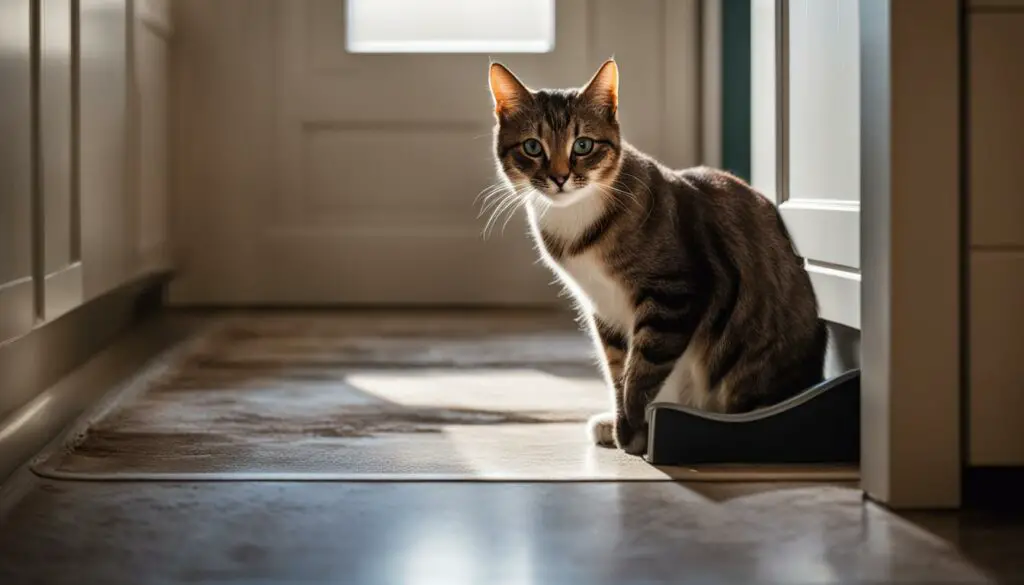
Requesting Assistance
Cats meowing in the bathroom may be requesting assistance for various reasons. If your cat meows after using the litter tray, it could indicate difficulty in eliminating, constipation, or intestinal blockages. In such cases, it is important to provide the necessary support to ensure your cat’s well-being.
One way to assist your cat is by gently stimulating their anus, which can help with elimination. Additionally, consulting with a veterinarian to review your cat’s diet may be necessary to address any underlying digestive issues. By addressing these concerns, you can help alleviate your cat’s discomfort and reduce excessive meowing in the bathroom.
Remember, each cat is unique, and understanding their individual needs is essential. By providing the necessary assistance and seeking veterinary guidance when needed, you can help create a calm and comfortable bathroom experience for both you and your feline companion.
Seeking Veterinary Consultation
If your cat continues to meow excessively in the bathroom or displays other concerning signs, it is important to consult a veterinarian. Excessive meowing could be a sign of underlying medical or behavioral issues that require professional attention. A veterinarian can assess your cat’s health and behavior and recommend appropriate interventions to address the root causes of the meowing.
Requesting a Reward
When cats meow in the bathroom, one possible reason is that they are requesting a reward. This behavior is often seen in cats who have recently been litter trained. After successfully using the litter tray, they may expect positive reinforcement or a treat as a form of reward. Providing verbal encouragement or petting can fulfill their expectation and reinforce their desired behavior.
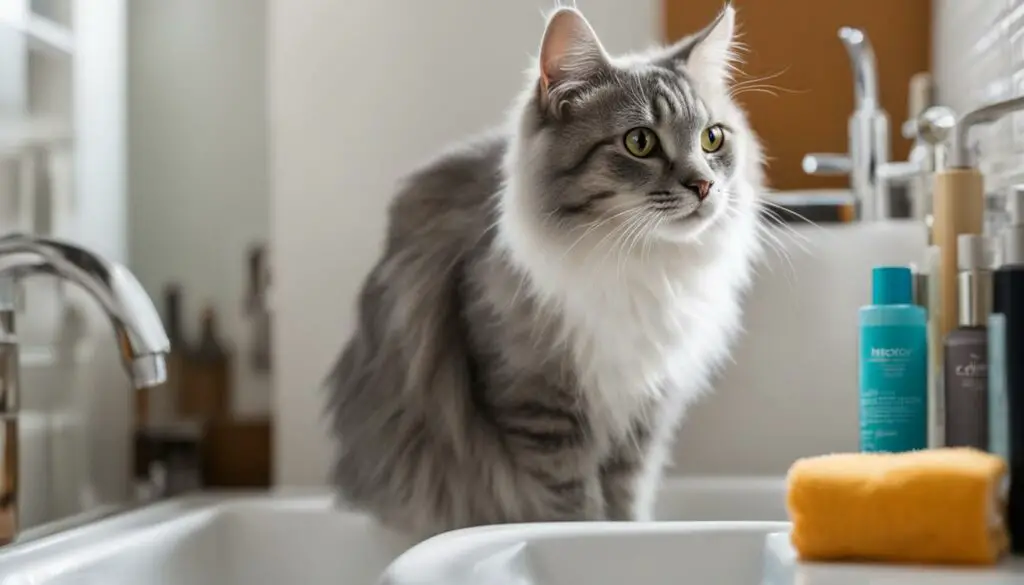
It is important to note that rewarding your cat should be done immediately after they use the litter tray to create a clear association between the action and the reward. By consistently providing positive reinforcement, you can reinforce the habit of using the litter tray and reduce excessive meowing in the bathroom.
In addition to rewards, it is also important to ensure that your cat has a comfortable and appealing litter tray. A clean litter box with the right type of litter and appropriate depth can further motivate your cat to use it without excessive meowing. Experimenting with different litter options can help you determine your cat’s preference and avoid any potential dislikes or discomfort.
Request for Cleaning
When your cat meows in the bathroom, it could be a request for cleaning the litter box. Cats are notorious for their cleanliness, and they prefer a clean litter box for their business. After using the litter tray, your cat may meow to remind you to remove the waste and change the litter. This behavior is their way of maintaining a clean and odor-free environment.
Establishing a routine for litter box maintenance can help reduce the frequency of your cat’s meowing. Make sure to scoop the litter box at least once a day, removing any clumps or waste. It’s also important to completely change the litter regularly to keep it fresh. By keeping the litter box clean and odor-free, you can reduce your cat’s need to meow for cleaning.
Building trust with your cat is also essential in reducing meowing for cleaning. Cats are creatures of habit, and they appreciate consistency. By following a regular cleaning schedule, your cat will learn to trust that their litter box will always be kept clean. This trust can help minimize their meowing and create a more peaceful bathroom experience for both you and your feline friend.
| Benefits of Regular Cleaning | How to Maintain a Clean Litter Box |
|---|---|
|
|
By prioritizing cleanliness and maintaining a clean litter box, you can help address your cat’s request for cleaning and create a more harmonious bathroom experience. Remember to pay attention to your cat’s behavior and consult a veterinarian if their meowing becomes excessive or if you notice any other concerning signs.
Announcing Displeasure
When a cat meows in the bathroom, it can sometimes be their way of announcing displeasure. Cats are known for being particular about their preferences, and this extends to their bathroom habits as well. If your cat meows after using the litter tray, it may be expressing its dissatisfaction with certain aspects of the litter box or litter itself.
One possible reason for meowing is a change in the litter. Cats can be sensitive to changes in scent, texture, or location of the litter box, and they may vocalize their disapproval. It’s important to observe your cat’s behavior and see if there have been any recent changes to the litter that could be causing the dissatisfaction.
Another reason for meowing could be insufficient or excessive litter. Cats have their own preferences when it comes to the depth and amount of litter in the box. If they feel that there is not enough or too much litter, they may meow to signal their discomfort.
| Reasons for Announcing Displeasure | Solutions |
|---|---|
| Change in litter | Gradually introduce new litter and mix it with the old one. |
| Insufficient litter | Add more litter to meet your cat’s preferences. |
| Excessive litter | Remove some litter to provide a more comfortable depth. |
To address your cat’s meowing due to displeasure, it’s important to identify and resolve the underlying issue. By understanding your cat’s preferences and making adjustments to the litter box, you can create a more comfortable bathroom environment for your feline friend.
Expression of Pain
When a cat meows loudly after using the litter tray in the bathroom, it could be a sign of pain or discomfort. Cats are known to vocalize when they are experiencing physical distress, and this behavior may indicate the presence of underlying health issues. Common conditions that can cause pain during elimination include arthritis, urinary tract infections, cystitis, intestinal blockages, and swollen anal glands. It’s important to pay attention to this meowing behavior and seek veterinary attention to address the cat’s pain and discomfort.
In cases of arthritis, a condition that affects the joints, cats may find it painful to assume the required position for eliminating in the litter box. This discomfort can lead to excessive meowing as a way for them to communicate their distress. Urinary tract infections, cystitis, and intestinal blockages can cause pain during elimination, leading to vocalization in the bathroom. Swollen anal glands can also be a source of discomfort and result in meowing after using the litter tray.
Identifying and addressing the underlying causes of a cat’s pain is crucial for their well-being. A veterinarian can perform a thorough examination to diagnose and treat any health issues contributing to the cat’s vocalization. This may involve diagnostic tests, such as urine analysis or X-rays, to determine the specific cause of the pain. Once the underlying condition is treated, the cat’s meowing in the bathroom may decrease or stop altogether, resulting in a more comfortable and peaceful litter box experience.
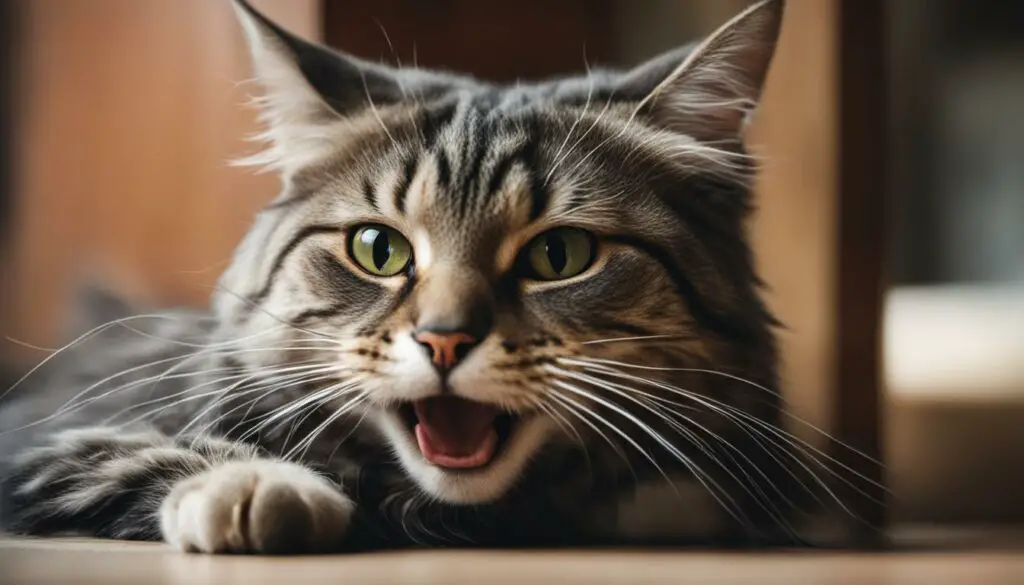
Common Causes of Pain in Cats
| Cause | Symptoms |
|---|---|
| Arthritis | Limping, difficulty jumping, stiffness, decreased activity |
| Urinary Tract Infections | Frequent urination, straining to urinate, blood in urine |
| Cystitis | Frequent urination, straining to urinate, blood in urine, urinating outside the litter box |
| Intestinal Blockages | Vomiting, constipation, loss of appetite, abdominal pain |
| Swollen Anal Glands | Scooting on the floor, licking or biting the rear end, discomfort when sitting |
“Understanding and addressing the root cause of a cat’s pain is essential for their overall health and well-being. If a cat’s meowing after using the litter tray in the bathroom persists or is accompanied by other concerning symptoms, it’s important to consult a veterinarian for proper evaluation and treatment.” – Dr. Jessica Reed, DVM
Cats Meowing in the Bathroom – Other Possible Causes
While cats meowing in the bathroom can often be attributed to their litter box behavior, there are other possible causes for this vocalization. It’s important to consider these factors to better understand your cat’s needs and behavior.
One possible reason for your cat’s meowing in the bathroom is excitement. Cats can become overwhelmed with anticipation, especially if they associate the bathroom with positive experiences like receiving treats or playtime. This excitement can manifest as vocalization. Additionally, if your cat has a previously established routine that involves bathroom time, they may meow out of excitement for the upcoming activity.
Stress can also be a contributing factor to cats meowing in the bathroom. Changes in the environment, such as the introduction of new people or animals, can cause anxiety for your cat. The bathroom may serve as a safe space, and your cat may seek comfort or express their stress through vocalization. Providing a calm and secure environment with familiar scents and objects can help alleviate their anxiety.
Another possible cause for meowing in the bathroom is attention-seeking behavior. Cats are known to be highly social animals, and they may meow to get your attention. They may want to be petted, played with, or simply seek reassurance. It’s important to provide regular interaction and engagement with your cat, ensuring they receive the attention they need.
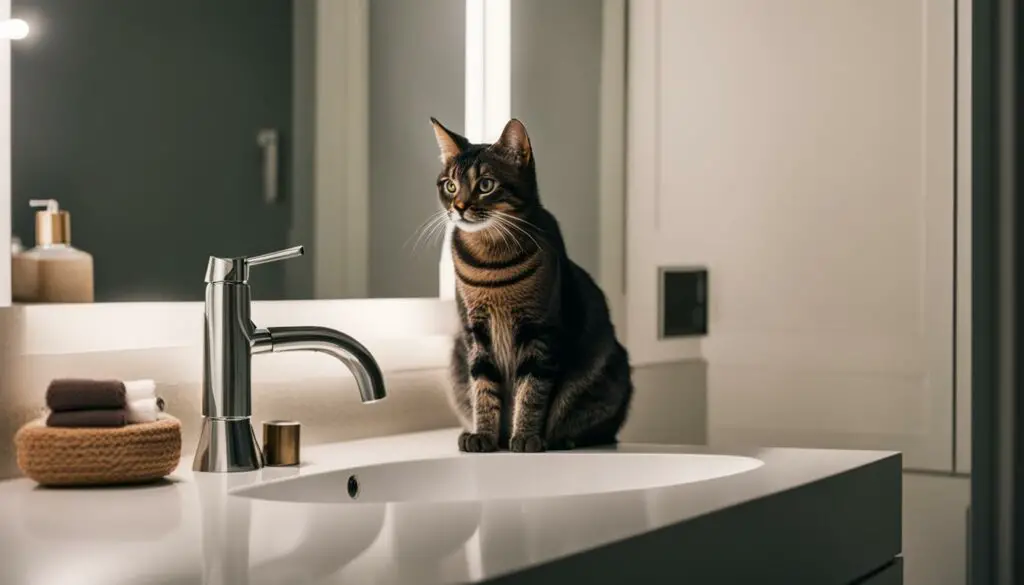
In older cats, confusion can also lead to increased vocalization in the bathroom. Cats experiencing cognitive decline or age-related conditions may feel disoriented, and the bathroom may provide a sense of familiarity. Providing adequate lighting and creating a consistent routine can help reduce confusion and limit excessive meowing in older cats.
It’s important to remember that every cat is unique, and the reasons for meowing in the bathroom may vary. By observing your cat’s behavior, identifying potential triggers, and providing a supportive environment, you can help address their needs and reduce unnecessary vocalization.
Cats Meowing in the Bathroom – Environmental Stressors
If your cat meows excessively in the bathroom, it could be due to environmental stressors. Cats are sensitive creatures and changes in their surroundings can cause anxiety and increased vocalization. Here are some common environmental stressors that may be causing your cat to meow in the bathroom:
- New people or animals in the household
- Changes in the bathroom layout or furniture
- Loud noises or disruptions near the bathroom
- Lack of hiding spots or perches in the bathroom
These stressors can make your cat feel unsettled and insecure in the bathroom, leading to excessive meowing. To help alleviate this behavior, create a calm and comfortable environment for your cat. Consider providing hiding spots and vertical spaces in the bathroom where your cat can feel safe and secure. Minimize disruptions and loud noises in the area, and ensure that the bathroom remains a quiet and peaceful space for your cat.
“Cats are highly sensitive to changes in their environment, and even small alterations can cause stress and anxiety.”
Creating a Stress-Free Bathroom Environment
To create a stress-free bathroom environment for your cat, you can:
- Introduce any new people or animals slowly and gradually, giving your cat time to adjust.
- Use pheromone sprays or diffusers in the bathroom to help promote a sense of calmness.
- Ensure that there are hiding spots or perches in the bathroom where your cat can retreat to if they feel anxious.
- Maintain a consistent bathroom routine and avoid making sudden changes to the layout or furniture.
By addressing environmental stressors and providing a calm and secure bathroom environment, you can help reduce excessive meowing and create a more peaceful experience for both you and your cat.
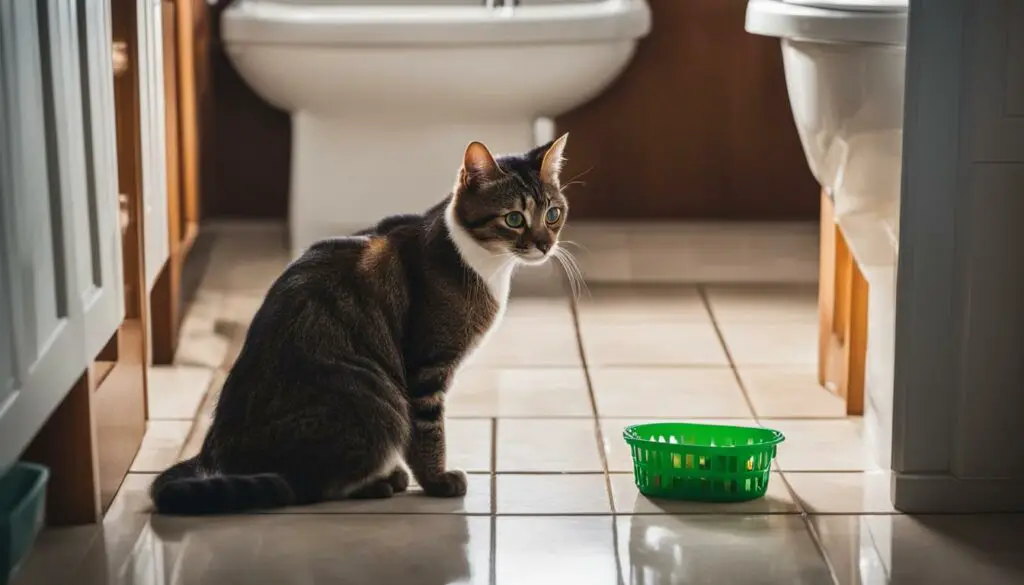
Cats Meowing in the Bathroom – Aging and Confusion
As cats age, they may experience confusion and disorientation, leading to increased meowing in the bathroom. This behavior can be attributed to cognitive decline and changes in their sensory perception. Older cats may become more vocal as they struggle to navigate their surroundings and may seek reassurance and comfort in familiar spaces like the bathroom.
It is important to provide adequate lighting in the bathroom to help older cats see and navigate more easily. Placing nightlights or motion sensor lights near the litter box area can reduce their anxiety and confusion. Additionally, consulting a veterinarian is essential to rule out any underlying medical conditions that may contribute to their behavior.
Creating a calm and comforting environment for older cats is crucial to managing their meowing in the bathroom. Ensuring they have easy access to the litter box, keeping the area clean and free from obstacles, and providing additional litter boxes on multiple floors can help them feel more secure. Offering interactive toys, vertical spaces, and cozy hiding spots in the bathroom can also provide them with a sense of safety and reduce their anxiety.
Older cats may benefit from a predictable routine and consistent daily care. Establishing meal times, play sessions, and quiet times in the bathroom can help them feel more at ease and lessen their overall confusion. Patience and understanding are key in managing their behavior, and providing gentle reassurance and affection can help them feel more secure in their environment.
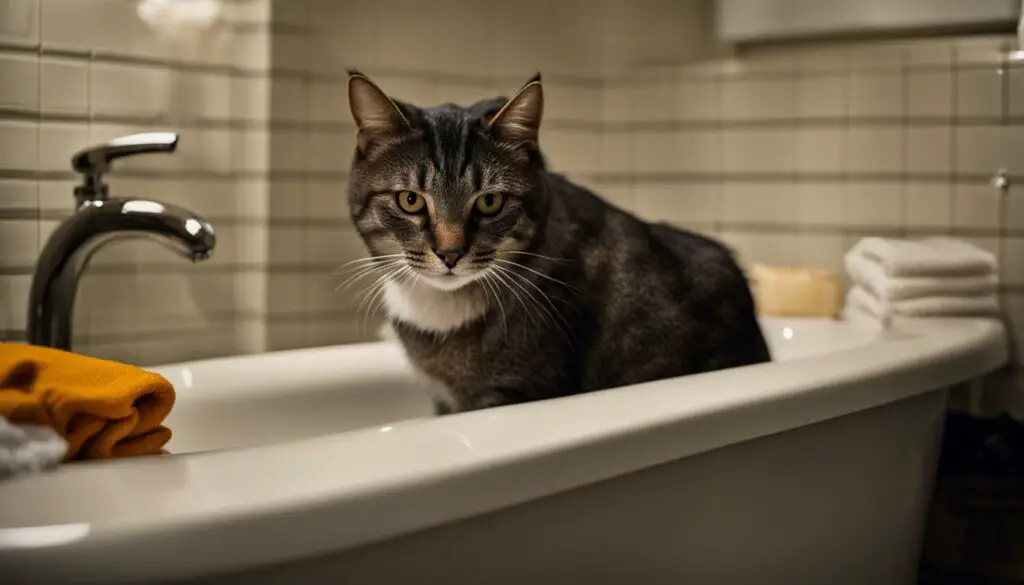
Table: Common Behaviors of Aging Cats in the Bathroom
| Behavior | Description |
|---|---|
| Pacing and wandering | Older cats may meow and wander around the bathroom due to confusion and disorientation. |
| Increased vocalization | They may meow more frequently in the bathroom as a way to seek attention or express their anxiety. |
| Accidents outside the litter box | Some older cats may have difficulty finding or using the litter box consistently due to cognitive decline or physical limitations. |
| Seeking comfort and security | Older cats may spend more time in the bathroom as it provides them with a familiar and secure environment. |
Cats Meowing in the Bathroom – Heat Cycle
When it comes to cats meowing in the bathroom, one possible cause is their heat cycle. Female cats in heat can become extremely vocal, and the bathroom may amplify their meowing. This behavior is driven by their instinct to attract males. Even male cats can meow in response to the scent of a female in heat nearby. Spaying or neutering your cat is an effective solution to prevent excessive vocalization related to heat cycles.
During the heat cycle, female cats release pheromones and exhibit behaviors like increased affection, restlessness, and rubbing against objects. This hormonal surge triggers a strong desire to mate and may cause them to meow loudly and persistently. The bathroom, with its enclosed space and limited distractions, can intensify their vocalization.
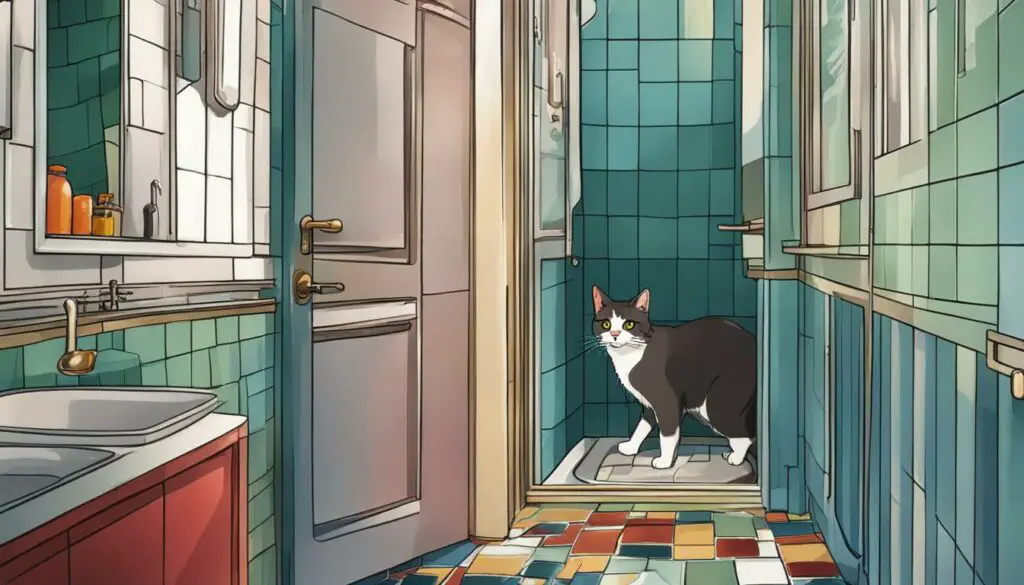
| Causes of Cats Meowing in the Bathroom – Heat Cycle | Solutions |
|---|---|
| Female cats in heat attract males through vocalization | Spay or neuter your cat to eliminate heat cycles |
| Females release pheromones that trigger meowing | Keep your female cat indoors during heat cycles |
| Males detect the scent of a female in heat | Provide a calm and secure environment to reduce stress |
Meowing during the heat cycle is a natural behavior for cats. Spaying or neutering your cat can help eliminate excessive vocalization and prevent unwanted litters. If you have any concerns or questions about your cat’s heat cycle, it’s best to consult with a veterinarian.
It’s important to note that the heat cycle in cats is a temporary phase, typically occurring every 2 to 3 weeks during the breeding season. By spaying or neutering your cat, you can help regulate their behavior and provide a more peaceful bathroom experience for both of you.
Interaction and Attention for Cats Meowing in the Bathroom
When it comes to cats meowing in the bathroom, providing appropriate interaction and attention can play a significant role in managing this behavior. Cats are social creatures and require mental and physical stimulation to thrive. By engaging with your cat in a positive and enriching manner, you can help reduce excessive meowing and create a harmonious bathroom experience.
One way to interact with your cat is through regular playtime. Cats have a natural instinct to hunt and play, and providing them with toys and interactive games can help satisfy this need. Use toys that encourage your cat to chase, pounce, and bat, as this mimics their natural hunting behavior. Play sessions should be scheduled throughout the day to ensure your cat gets enough exercise and mental stimulation.
Additionally, spending quality time with your cat outside of the bathroom can also have a positive impact on their behavior. Cats love attention and affection from their owners, so set aside dedicated time each day to cuddle, groom, or simply sit and relax with your furry friend. This can help strengthen the bond between you and your cat, making them feel secure and content.
| Interaction Tips for Cats Meowing in the Bathroom |
|---|
| 1. Playtime: Engage your cat in regular interactive play sessions using toys that encourage their natural hunting instincts. |
| 2. Quality Time: Set aside dedicated time each day to spend with your cat, providing attention, affection, and grooming if necessary. |
| 3. Verbal Interaction: Talk to your cat in a soothing and reassuring tone, using their name and providing positive reinforcement for calm behavior. |
| 4. Ignore Meowing: Ignore constant meowing in the bathroom and reward your cat when they are quiet, reinforcing the desired behavior. |
Remember, consistency is key when it comes to interacting with your cat. Establish a routine that includes scheduled playtime and one-on-one attention. This will help your cat feel secure and fulfilled, reducing the need for excessive meowing in the bathroom. If you continue to experience issues with your cat’s behavior, it may be helpful to consult with a veterinarian or professional animal behaviorist for further guidance.
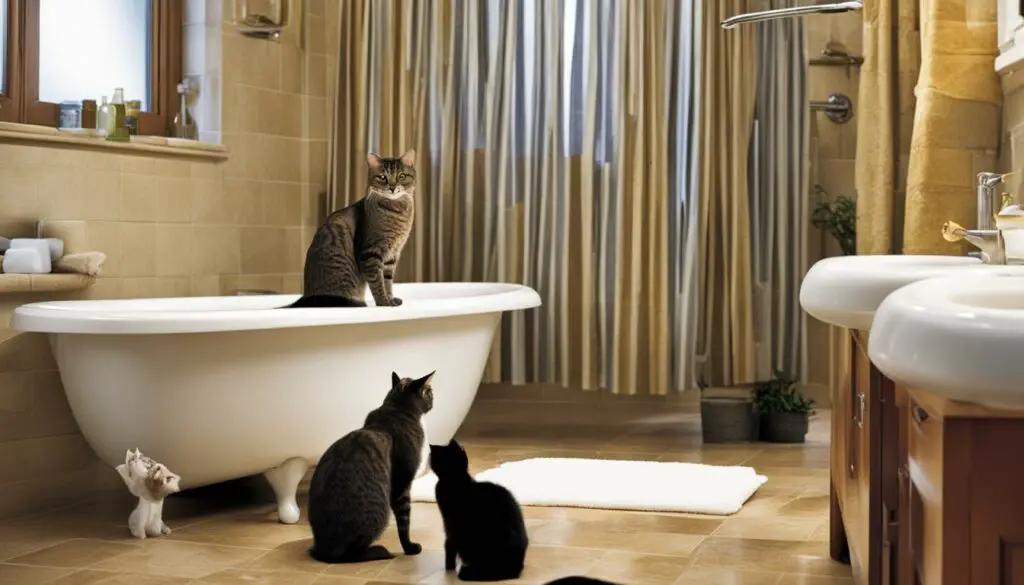
Consulting a Veterinarian for Excessive Meowing
If your cat’s meowing in the bathroom becomes excessive or is accompanied by other concerning signs, it’s important to consult a veterinarian. Excessive meowing can be a sign of underlying medical or behavioral issues that require professional attention. By seeking veterinary guidance, you can ensure that your cat receives the appropriate care and support.
A veterinarian will conduct a thorough examination to assess your cat’s overall health. They may ask questions about your cat’s behavior, diet, litter box habits, and any recent changes in their environment. This information will help determine if there are any underlying medical conditions or behavioral factors contributing to the excessive meowing.
Based on their evaluation, the veterinarian may recommend diagnostic tests to rule out any health concerns. These tests can include blood work, urinalysis, and imaging scans. If a medical condition is identified, the veterinarian will develop a treatment plan tailored to your cat’s specific needs.
If no medical issues are found, the veterinarian may refer you to a cat behavior specialist or recommend behavioral interventions to address the excessive meowing. These interventions may involve environmental modifications, training techniques, or the use of pheromone products to reduce stress and anxiety.

Maintaining a Calm and Comfortable Environment
Creating a calm and comfortable environment for your cat is essential to reduce excessive meowing in the bathroom. By ensuring consistent routines, appropriate litter box conditions, and minimal changes, you can help alleviate stress and promote a harmonious bathroom experience for both you and your feline friend.
Start by providing your cat with hiding spots and vertical spaces where they can retreat and feel secure. This could include cat trees, shelves, or window perches. Having these elevated areas will allow your cat to observe their surroundings and feel a sense of control, reducing anxiety and excessive meowing.
To further create a calming environment, consider providing stimulating toys and interactive play sessions for your cat. Playtime not only helps burn off excess energy but also strengthens the bond between you and your pet. Experiment with different toys and play techniques to find what your cat enjoys the most.
Table: Tips for Maintaining a Calm and Comfortable Environment
| Tips | Description |
|---|---|
| Create Consistent Routines | Stick to a regular schedule for feeding, playtime, and litter box cleaning. Cats thrive on predictability, and a consistent routine helps reduce stress. |
| Ensure Adequate Litter Box Conditions | Keep the litter box clean and provide enough litter for your cat to comfortably eliminate. Avoid sudden changes in litter type or location. |
| Minimize Environmental Changes | Avoid making unnecessary changes in the bathroom, such as rearranging furniture or introducing new scents, which can disrupt your cat’s sense of familiarity. |
| Offer Calming Scents | Consider using synthetic pheromone sprays or diffusers in the bathroom to create a soothing atmosphere for your cat. |
| Provide Hiding Spots | Ensure your cat has access to hiding spots or elevated areas where they can retreat and feel safe. |
| Engage in Interactive Play | Regularly engage in play sessions with your cat using interactive toys to provide mental and physical stimulation. |
Remember, maintaining a calm and comfortable environment for your cat takes time and patience. Each cat is unique, and it may require some trial and error to find the strategies that work best for your feline companion. By prioritizing their comfort and well-being, you can help reduce excessive meowing and create a peaceful bathroom space for your cat.
Cats Meowing in the Bathroom – Understanding Feline Behavior
Have you ever wondered why your cat meows when you’re in the bathroom? As a cat owner myself, I’ve dived deep into the world of feline behavior to uncover the reasons behind this peculiar habit.
When your cat meows in the bathroom, it can mean a variety of things. It might be signaling excitement, requesting assistance, asking for a reward, or even expressing pain due to health issues like a urinary tract infection or arthritis.
Excitement after using the litter tray is one common reason for bathroom meowing. Cats may race around the house and share the scent of their waste as a form of scent marking, showing off their healthy bowel movement.
However, if your furry friend meows persistently, it’s essential to pay attention. Excessive meowing, accompanied by other concerning signs, might indicate underlying medical or behavioral problems. In such cases, consulting a veterinarian is crucial to ensure your cat’s well-being.
FAQ
Why does my cat meow when I’m in the bathroom?
Cats may meow in the bathroom for various reasons, including excitement, requesting assistance, a desire for rewards, asking for cleaning, and expressing pain due to health conditions like urinary tract infections or arthritis.
Why do cats meow after they poop?
Cats meow after pooping to communicate different messages, such as excitement after successful elimination, requesting assistance if they’re unable to eliminate or want protection, asking for a reward, or indicating the need for cleaning the litter box. Meowing can also signal displeasure with changes in litter, insufficient or excessive litter, or dislike of the litter tray.
Why do cats meow after using the litter tray?
Cats may meow after using the litter tray due to the excitement of a healthy bowel movement. They may race around the house to burn off energy and share the scent of their waste as a form of scent marking.
Why does my cat meow after using the litter tray?
If a cat meows after using the litter tray, it may be signaling a need for assistance. This could be due to difficulty in eliminating, constipation, or intestinal blockages. In such cases, gently stimulating the cat’s anus or reviewing its diet with a veterinarian may be necessary.
Does my cat expect a reward for using the litter tray?
Some cats expect a reward for using the litter tray, especially if they’ve been recently litter trained. Providing positive verbal encouragement or petting can fulfill this expectation.
Why does my cat meow after using the litter box?
Cats prefer a clean litter box and may meow after using it to remind their owners to remove the waste and change the litter. Establishing a routine and building trust with the cat can reduce the frequency of meowing for cleaning.
Why does my cat meow after using the litter tray?
Cats can meow after using the litter tray if they are unhappy with changes in the litter, insufficient or excessive litter, or if they dislike the litter tray itself. Cats may prefer a familiar litter type and can be sensitive to changes in scent, texture, or location of the litter box.
Why does my cat meow loudly after using the litter box?
Cats may meow loudly after using the litter tray if they are in pain due to conditions like arthritis, urinary tract infections, cystitis, intestinal blockages, or swollen anal glands. These health issues can make elimination uncomfortable and require veterinary attention.
Why does my cat meow in the bathroom for reasons not related to using the litter tray?
Cats may meow in the bathroom for reasons not related to using the litter tray. It could be due to excitement, stress, attention-seeking, hunger, or confusion in older cats. It’s important to observe your cat’s behavior and consult a vet if the meowing becomes excessive or if there are other concerning signs.
What can cause cats to meow more frequently in the bathroom?
Environmental stressors like changes in the bathroom, new people, new animals, or other disturbances can cause cats to meow more frequently in the bathroom. Providing a comfortable and secure environment for your cat can help reduce anxiety-related meowing.
Why do older cats meow more in the bathroom?
Older cats can experience confusion and disorientation, leading them to meow more in the bathroom. Providing adequate lighting and consulting a vet to address any underlying medical conditions can help manage this behavior.
Why do female cats meow in the bathroom?
Female cats in heat can become very vocal, meowing in the bathroom to attract males. Male cats can also meow if they detect a female in heat nearby. Spaying or neutering your cat can help eliminate excessive vocalization related to heat cycles.
How can I reduce excessive meowing in the bathroom?
Providing appropriate attention and interaction with your cat, along with regular playtime and exercise, can help reduce excessive meowing in the bathroom. Ignoring constant meowing and rewarding quiet behavior can also be effective strategies.
When should I consult a veterinarian about my cat’s meowing in the bathroom?
If your cat’s meowing in the bathroom becomes excessive or is accompanied by other concerning signs, it’s important to consult a veterinarian. They can assess your cat’s health and behavior to determine if there are underlying medical or behavioral issues.
How can I create a calm and comfortable environment for my cat in the bathroom?
Creating a calm and comfortable environment for your cat, with consistent routines, appropriate litter box conditions, and minimal changes, can help reduce excessive meowing in the bathroom. Providing hiding spots, vertical spaces, and stimulating toys can also help alleviate stress.
What should I do if my cat’s meowing in the bathroom is excessive?
Cats meow in the bathroom for various reasons, including communication, attention-seeking, discomfort, and environmental stressors. Understanding the underlying causes and addressing them can help manage excessive meowing and create a harmonious bathroom experience for both you and your cat. Remember to consult a veterinarian if you have concerns about your cat’s behavior or health.








